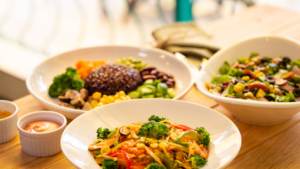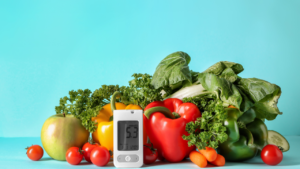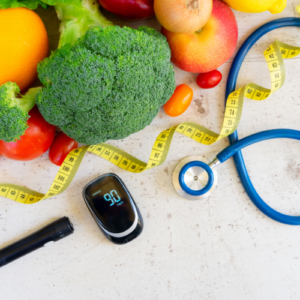Welcome to “Vegan Diabetic Diet Recipes” – your ultimate guide to crafting delicious meals tailored for individuals managing diabetes through a plant-based lifestyle.
This cookbook offers a diverse range of flavorful recipes that prioritize health and well-being while aligning with vegan and diabetic dietary guidelines.

Whether you’re newly diagnosed or a seasoned vegan, explore a variety of breakfast, lunch, dinner, snack, and dessert options designed to balance flavors, textures, and nutritional components.
Embrace the journey of nourishing your body with wholesome, plant-based ingredients that promote wellness and vitality.
Join us in celebrating the synergy between health-conscious eating and compassionate living through these delectable dishes.
1.Vegan Diabetic Diet Recipes idea
Eating a vegan diet while managing diabetes doesn’t mean sacrificing flavor or variety. In fact, it opens up a world of creative culinary possibilities.

Here are some delicious recipe ideas tailored to suit both vegan and diabetic dietary requirements.
- Quinoa Salad with Roasted Vegetables: Combine cooked quinoa with roasted vegetables like bell peppers, zucchini, and cherry tomatoes. Toss with a lemon-tahini dressing for a satisfying and nutritious meal.
- Tofu Stir-Fry: Sauté tofu with colorful stir-fry veggies such as broccoli, carrots, and snap peas. Season with low-sodium soy sauce and garlic for a flavorful dish that’s low in carbohydrates and high in protein.
- Chickpea and Spinach Curry: Simmer chickpeas and spinach in a fragrant tomato-based curry sauce seasoned with ginger, garlic, and cumin. Serve with brown rice or quinoa for a hearty and satisfying meal.
- Zucchini Noodles with Vegan Pesto: Spiralize zucchini into noodles and toss with homemade vegan pesto made from basil, pine nuts, garlic, and nutritional yeast. Top with cherry tomatoes and olives for a light and refreshing pasta alternative.
- Black Bean and Sweet Potato Chili: Cook black beans and sweet potatoes with onions, bell peppers, and tomatoes in a flavorful chili sauce seasoned with chili powder, cumin, and smoked paprika. This hearty chili is packed with fiber and protein to keep you feeling full and satisfied.
These recipes are not only delicious but also nutritious, providing a balance of carbohydrates, protein, and healthy fats to help manage blood sugar levels.
Experiment with different flavors and ingredients to find combinations that you enjoy, and don’t be afraid to get creative in the kitchen!
2. Nutritional Information for Vegan Diabetic Diet Recipes

When managing diabetes with a vegan diet, it’s essential to pay attention to the nutritional content of your meals to ensure they support stable blood sugar levels.
Here’s a breakdown of key nutritional considerations and tips for creating balanced vegan diabetic recipes:
- Carbohydrates: Opt for complex carbohydrates like whole grains (quinoa, brown rice, barley) and legumes (lentils, chickpeas, black beans) over refined grains and sugars. These carbs are rich in fiber, which helps slow down the absorption of glucose into the bloodstream, preventing spikes in blood sugar levels.
- Protein: Include plant-based sources of protein such as tofu, tempeh, seitan, lentils, beans, and quinoa in your meals to help stabilize blood sugar levels and promote satiety. Aim to incorporate protein-rich foods into each meal to support overall health and well-being.
- Fiber: Focus on fiber-rich foods like fruits, vegetables, whole grains, legumes, nuts, and seeds, which help regulate blood sugar levels, improve insulin sensitivity, and support digestive health. Aim to include a variety of high-fiber foods in your diet to promote optimal health and blood sugar management.
- Healthy Fats: Incorporate sources of healthy fats such as avocados, nuts, seeds, and olive oil into your meals in moderation. These fats help slow down the absorption of carbohydrates, preventing rapid spikes in blood sugar levels, and provide essential nutrients for overall health.
- Portion Control: Pay attention to portion sizes to prevent overeating and ensure balanced meals. Use measuring cups, spoons, or food scales to portion out ingredients and avoid consuming excessive calories, carbohydrates, or fats that can impact blood sugar control.
By incorporating these nutritional tips into your meal planning and recipe creation, you can create delicious and satisfying vegan diabetic meals that support your health and well-being.
3. Meal Planning Tips for Vegan Diabetic Diet Recipes
Meal planning is key to successfully managing diabetes with a vegan diet. Here are some tips to help you create balanced and nutritious meal plans:
- Plan Ahead: Take time each week to plan your meals and snacks in advance. Choose recipes that incorporate a variety of colorful fruits, vegetables, whole grains, legumes, nuts, and seeds to ensure you’re getting a wide range of nutrients.
- Focus on Whole Foods: Base your meals around whole, minimally processed plant foods such as fruits, vegetables, whole grains, legumes, nuts, and seeds. These foods are rich in fiber, vitamins, minerals, and antioxidants, which are essential for managing blood sugar levels and promoting overall health.
- Balance Your Plate: Aim to include a balance of carbohydrates, protein, and healthy fats in each meal to help stabilize blood sugar levels and keep you feeling full and satisfied. Fill half your plate with non-starchy vegetables, a quarter with whole grains or starchy vegetables, and a quarter with protein-rich foods.
- Experiment with Recipes: Don’t be afraid to try new recipes and experiment with different flavors and ingredients. Look for inspiration from cookbooks, websites, and blogs specializing in vegan diabetic recipes, and adapt recipes to suit your taste preferences and dietary needs.
- Be Mindful of Portion Sizes: Pay attention to portion sizes to prevent overeating and ensure balanced meals. Use measuring cups, spoons, or food scales to portion out ingredients, and practice mindful eating to tune into your body’s hunger and fullness cues.
- Stay Hydrated: Drink plenty of water throughout the day to stay hydrated and support optimal blood sugar control. Limit sugary beverages and opt for water, herbal tea, or sparkling water flavored with fresh fruit instead.
By following these meal planning tips, you can create delicious and nutritious vegan diabetic meals that support your health and well-being.
4. Ingredient Substitutions for Vegan Diabetic Diet Recipes
When following a vegan diet while managing diabetes, it’s important to choose ingredients that are low in carbohydrates and sugar and high in fiber, protein, and healthy fats. Here are some ingredient substitutions and alternatives to consider when creating vegan diabetic recipes:
- Flour: Replace refined white flour with whole grain flours such as almond flour, coconut flour, oat flour, or chickpea flour. These flours are lower in carbohydrates and higher in fiber, protein, and nutrients, making them a healthier choice for managing blood sugar levels.
- Sweeteners: Substitute refined sugars with natural sweeteners such as stevia, erythritol, monk fruit, or xylitol, which have minimal impact on blood sugar levels. Alternatively, use small amounts of natural sweeteners like maple syrup, agave nectar, or date paste to sweeten recipes while still being mindful of carbohydrate intake.
- Oil: Instead of using refined oils like vegetable oil or canola oil, opt for healthier plant-based fats such as olive oil, avocado oil, coconut oil, or flaxseed oil. These oils are rich in monounsaturated or polyunsaturated fats, which can help improve insulin sensitivity and support heart health.
- Dairy: Replace dairy products like milk, cheese, and yogurt with plant-based alternatives such as almond milk, coconut milk, soy milk, cashew cheese, or coconut yogurt. These dairy-free alternatives are lower in carbohydrates and cholesterol and free from lactose, making them suitable for vegan and diabetic diets.
- Processed Foods: Minimize consumption of processed foods like vegan meats, cheeses, and desserts, which may be high in refined carbohydrates, sugars, and unhealthy fats. Instead, focus on whole, minimally processed plant foods like fruits, vegetables, whole grains, legumes, nuts, and seeds.
By making these ingredient substitutions and choosing whole, nutrient-dense foods, you can create delicious and satisfying vegan diabetic recipes that support your health and well-being.
5. Cooking Techniques for Vegan Diabetic Recipes
When preparing vegan diabetic recipes, choosing the right cooking techniques can help maximize flavor and nutritional value while minimizing added fats and sugars. Here are some cooking techniques to consider:
- Grilling: Grilling vegetables, tofu, tempeh, or seitan adds a smoky flavor and caramelization without the need for added oils. Brush vegetables lightly with olive oil or a marinade made from herbs, spices, and citrus juice for extra flavor.
- Roasting: Roasting vegetables in the oven enhances their natural sweetness and flavor. Toss vegetables like sweet potatoes, carrots, Brussels sprouts, and cauliflower with herbs, spices, and a small amount of olive oil before roasting at high heat until tender and golden brown.
- Steaming: Steaming vegetables preserves their natural nutrients and flavors while keeping them tender and crisp. Steam vegetables like broccoli, green beans, asparagus, and spinach until just cooked through, then season with herbs, spices, or a squeeze of lemon juice.
- Sautéing: Sautéing vegetables, tofu, or tempeh in a non-stick skillet with a small amount of olive oil or vegetable broth adds flavor and texture without excess added fats. Add aromatics like garlic, onions, ginger, or chili peppers for extra flavor.
- Baking: Baking tofu, tempeh, or vegetables in the oven creates a crispy exterior while keeping the interior moist and tender. Coat tofu or tempeh with a marinade or spice rub before baking for added flavor and texture.
- Blending: Blending fruits and vegetables into smoothies or soups creates creamy textures without the need for added dairy or fats. Add leafy greens like spinach or kale to smoothies for an extra boost of nutrients.
By incorporating these cooking techniques into your meal preparation, you can create delicious and nutritious vegan diabetic recipes that are full of flavor and satisfaction.
6. Building a Supportive Community for Vegan Diabetic Diet
Managing diabetes with a vegan Diabetic diet can be challenging, but having a supportive community can make a big difference. Here are some ways to build a supportive community to help you on your journey:
- Join Online Forums: Look for online forums, groups, or social media communities dedicated to veganism and diabetes. These groups can provide valuable support, advice, and encouragement from others who are also managing their condition with a vegan diet.
- Attend Support Groups: Check if there are any local support groups or meetups for individuals with diabetes or vegans in your area. Meeting face-to-face with others who share similar experiences can be incredibly empowering and motivating.
- Connect with Healthcare Professionals: Work closely with your healthcare team, including your doctor, dietitian, or diabetes educator, to develop a personalized meal plan and lifestyle recommendations that meet your specific needs and goals.
- Share Recipes and Tips: Share your favorite vegan diabetic recipes, cooking tips, and meal planning strategies with friends, family, and community members. By sharing your knowledge and experiences, you can inspire others to adopt healthier eating habits and manage their diabetes more effectively.
- Attend Workshops or Classes: Look for workshops, cooking classes, or educational events focused on veganism and diabetes in your area. These events can provide valuable information, resources, and hands-on experience to help you succeed on your journey.
- Start Your Own Community: If you can’t find an existing community that meets your needs, consider starting your own! Organize potluck dinners, recipe swaps, or walking groups with friends, family, or neighbors who share similar interests in veganism and diabetes.
By building a supportive community of like-minded individuals, you can find encouragement, inspiration, and practical tips to help you thrive on your journey to managing diabetes with a Vegan Diabetic Diet.
Conclusion
Managing diabetes with a Vegan Diabetic Diet Recipes is not only possible but also delicious and satisfying.
By incorporating nutritious ingredients, balanced meal planning, and supportive communities into your lifestyle, you can successfully manage your condition while enjoying a wide variety of flavorful and nutritious vegan recipes.
Whether you’re looking for recipe ideas, nutritional information, meal planning tips, ingredient substitutions, cooking techniques, or a supportive community, there are resources and tools available to help you on your journey to optimal health and well-being.
Embrace the power of plant-based eating and take control of your health one delicious meal at a time!